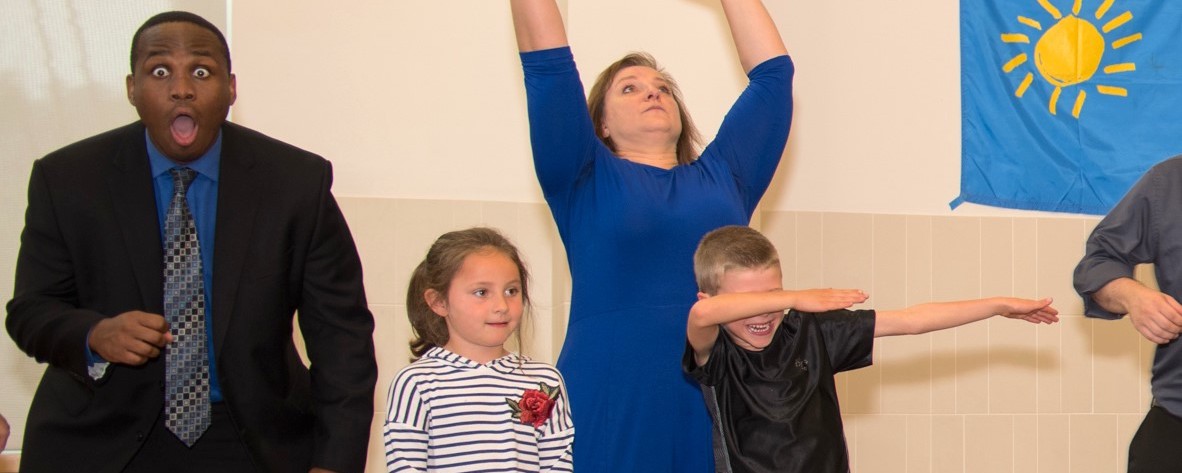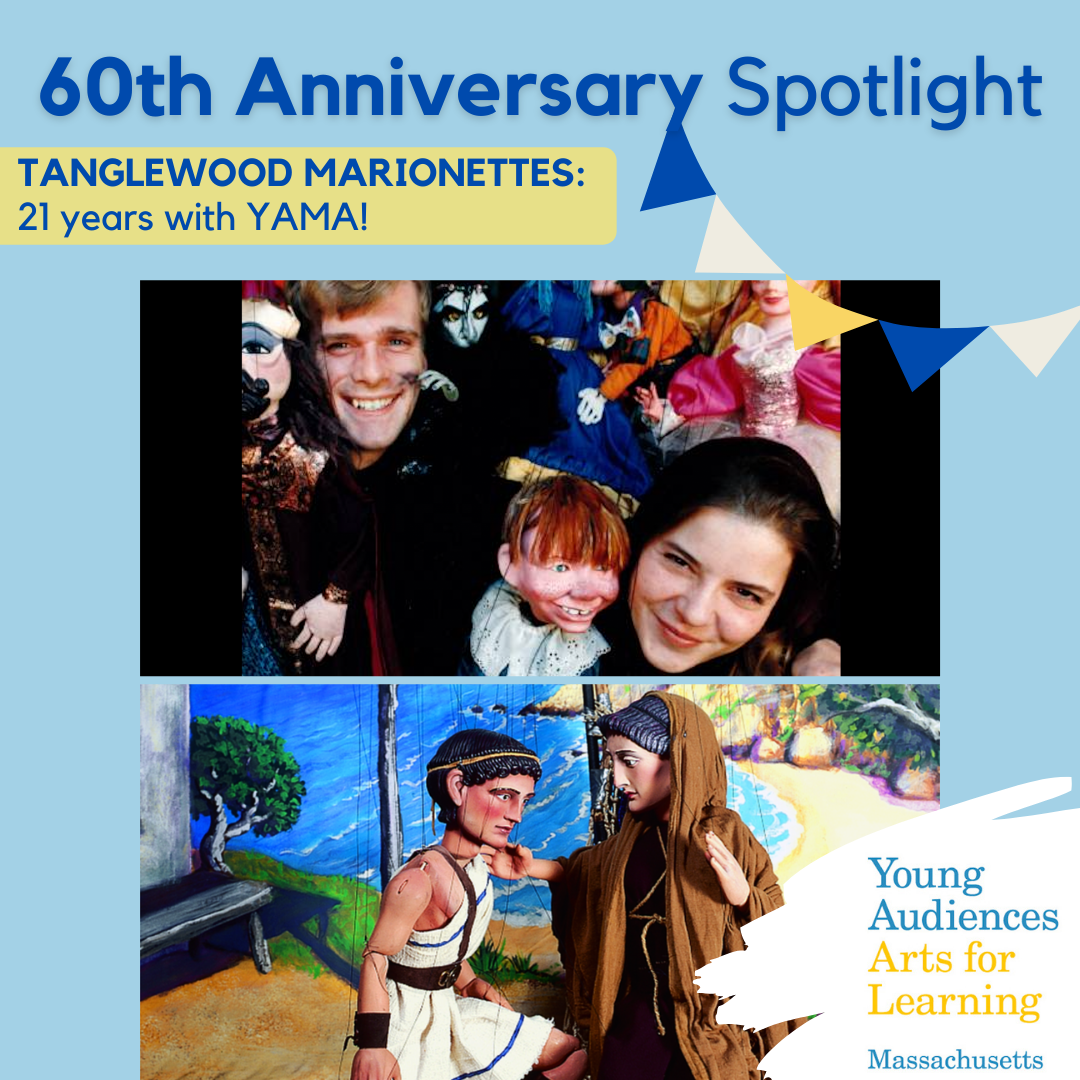Tanglewood Marionettes Celebrate 21 years with Young Audiences Arts for Learning!
Nov 9, 2022
This month, Young Audiences Arts for Learning is delighted to celebrate 21 wonderful years with the incredible puppeteers, Tanglewood Marionettes on our roster. Founded in 1993, they joined YAMA in 2001, and soon after were added to the roster of our sibling chapter in Connecticut. School communities bring back their wonderful programs, Perseus and Medusa, or The Fairy Circus, year after year, and even add some Puppeteering Workshops after a performance so kids can try out the art form themselves!
YAMA staff had a lovely time chatting with Anne and Peter Schaefer of the Tanglewood Marionettes about how they got into puppetry, and their experiences performing for young people.
How did you get your start in puppetry?
Peter: I grew up in a puppet family, and through theater I got into puppetry. I worked with another puppet company where I met Anne. We worked with that company for a long time before starting Tanglewood.
Anne: I actually didn’t have a puppetry background at all! I had an arts background. I studied Studio Art in college and I also had a minor in Philosophy. So when I graduated, I really didn’t know exactly what I wanted to do when I got out of college. The summer after I graduated I was at our family summer house, and I was reading the classifieds looking for a summer job, or what I thought was going to be a summer job. I took a job with Bennington Puppets which is the company that Peter was talking about, he started with them as well. Then that became my life’s work because in puppetry, not only did I really like the people involved, but there are all kinds of things, artistic things, that are appealing besides the painting and sculpting and design and theatrical aspects. There’s lots of different disciplines that you can try out, and for somebody like me who is a bit of a dilettante, who likes to do a lot of different things, it was the perfect fit.
Peter: And then we started Tanglewood in 1993.
Do you feel like you have specific roles, or do you both do everything?
Anne: We actually have quite different roles I think. We’re both puppeteers, and when we’re out performing, what we’re doing is relatively similar, but I’m sort of the artist and the builder and the Artistic Director if you want to call it that. Peter is very much the hands-on builder and he has a whole different way of thinking about the way things move and operate and get built. He knows how to make the puppets move. I think our skill-sets compliment each other quite well.
Peter: Anne really has the ability to have a vision of what it’s all going to look like before we start making anything, whereas I have to make it and then say, “That doesn’t work,” and then make it again and say, “Okay, that’s what we’ll do!” Anne gets rid of the extra steps in there. I’m more mechanically oriented, so when we’re talking through the ideas of what we want, I can sort of say, “Can we do it that way?!”
Anne: I think if we did both have more similar skill-sets, we’d probably be fighting more. But it’s been a good mix, and of course we’ve worked with other artists throughout our 30 years we’ve been in business. When we were first starting out, we really wanted to bring in other voices and to use other artists because we knew that we couldn’t do everything well, so we always wanted to try and engage as many people as we could.
Peter: The more people with unique knowledge that we can bring into a project, the better the project ends up being. Even though Anne has the overall vision, it really helps to have a good dialogue or a good script writer.
What is significant to you about performing for young people?
Peter: I grew up in Newton, and Young Audiences started bringing us to my middle school. It was a real treat for me to go back to my middle school. Once they had us come in, we’ve been back every year, and it’s part of their curriculum which is really special to me.
Anne: I just love how curious kids are. I know that sounds a bit cliche, and I love doing the performances, and I love making the shows, but I have to tell you some of the strongest and best parts of the performance for me are the questions that we get at the end. The kids are so so curious about what we do, about what they saw, about how to make the puppets, about how to write stories, the whole process. When we’re doing a workshop, and teaching them the marionette manipulation, I feel like there’s always one kid or at least one or two kids per audience or workshop when a lightbulb goes off. They’re like, “Oh, I can do this! This is something I’d like to explore.” Or, “Maybe I didn’t know I could be a good puppeteer but suddenly I have this skill-set that I wasn’t aware of.” Those moments are the things that I really love. Performing is great and we get a lot out of it when we perform, but those are the moments that really sing for me.
Peter: Performing live is such a give and take between the audience and the performers, and the amount of live performance available has diminished since I was a kid. So it’s so much fun to go to a group of students that don’t necessarily have the ability to see live performances anymore and bring them a live show. What the audience responds to, for us as performers inspires the performance to change and adapt to the audience that is there. Each show is always unique because each audience is unique even though it’s the same show. That interaction between the audience and the performers is special. We let people watch us perform up above, so when they’re curious about how we’re doing something, they can look up and see us. Every now and then, they'll notice me looking out at them, watching their reaction to what we’re doing because I can see them too. Most people that are watching get absorbed in the puppets and forget we’re there.
Anne: Showing the puppeteers is something that Bennington Puppets did…I remember the first show that I went to see of theirs, and I saw them getting up there and I thought, “Why don’t they hide themselves because they’re going to be so distracting?” Your ability to focus in and suspend your disbelief is so strong. You can phase them out, and it’s another interesting thing about puppetry and performing puppets. There’s that little trick that people do as far as being able to believe that the puppet is alive.
What are your hopes and dreams for the future of arts education?
Peter: Keep it up! There are many schools we perform at that we’ll get a comment afterwards saying, “Thank you for coming. Our students don’t have the opportunity to see a live performance. What you’ve brought to us today was a special thing.” That ability to introduce everyone to a live performance is really important because with the screens and video and cinema out there, it’s a special experience that you don’t get in your day to day life.
Anne: It’s interesting as we’ve been doing this for 30 years or closer to 40 now, it’s interesting to see the way schools and the arts have kind of changed and adapted. Over the past 10-15 years, school assembly programs have become more teaching artists and arts in education and that’s wonderful. I hope that continues. I hope that the arts continue in schools as much as possible. I’m hopeful and I’m also optimistic. I think there will always be a place for the arts in education.


